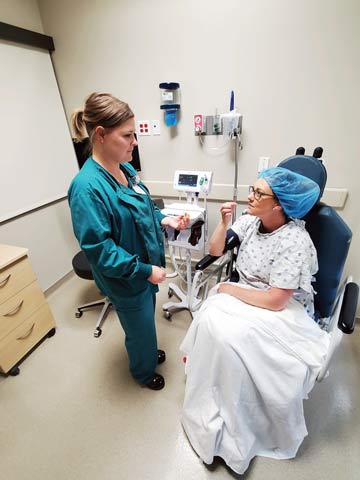Dr. Greenwood says IV-free cataract surgery is an efficient sedation option in ophthalmology, a specialty where every minute counts, including those minutes spent trying to start IVs when first-stick success is never a guarantee.
His patients receive 1 to 2 tablets based primarily on age: 2 for those under 65 years; 1.5 for those 65 to 75 and 1 for those over 75. (You can order the tablets in bulk from a 503B outsourcing pharmacy and administer them to patients without needing individual prescriptions.)
Dr. Greenwood says the tablets provide a consistent sedation, adding to his confidence as he performs surgery. In addition, he says, patients experience a euphoric high from the ketamine, which softens the discomforting sensations of surgery, including staring into the bright light of the surgical microscope.
William Wiley, MD, medical director of the Cleveland (Ohio) Eye Clinic, says inconsistencies in the timing of sedating cataract patients can occur when nurses start IVs and wait for anesthesia to administer midazolam, with doses varying from provider to provider. He points out that nurses, without waiting for anesthesia, can time the administration of sublingual sedation in pre-op, so patients are feeling its calming effects before they’re wheeled back to the OR and are fully sedated when surgery starts.
Dr. Wiley says liquid valium placed under the patient’s tongue has a long onset, making it less than ideal for relatively fast outpatient procedures, while liquid midazolam has a brief onset, but can have variable effect due to how much of the drug is administered and how much patients actually swallow.
Administering midazolam in a sublingual tablet ensures the administration of a full, accurate dose, according to Dr. Wiley, leading to a more consistent and predictable sedative effect. The total length of action is about an hour, he says, so patients are typically fully recovered after spending about 15 minutes in post-op.
Nurses, too, appreciate not having to fret about sticking older patients multiple times to find usable veins. “I’ll occasionally joke with my nurses by telling them we’re out of the tablets,” says Dr. Greenwood. “You can see their shoulders slump.”
Nurses can time the administration of sublingual sedation so patients feel calm before heading to the OR.
Jay Horowitz, CRNA, president of Quality Anesthesia Corp. in Sarasota, Fla., isn’t completely sold on the time-saving potential of oral sedation. He recognizes its appeal, but says he can’t count on the variability of its onset in individual patients, especially when sedating patients in high-volume practices.
Mr. Horowitz is often in the OR with ophthalmic surgeon T. Hunter Newsom, MD, owner of Newsom Eye in Tampa, Fla. “He’s a world-class surgeon and he’s fast — he can safely perform excellent cataract surgery in about 4 minutes,” says Mr. Horowitz. “I need to keep pace, and the onset of action of any oral sedative is variable. I don’t think it can match the predictability of popping in an IV.”
Sublingual sedation eliminates the need to start IVs, perhaps the most stress-inducing part of a relatively painless procedure. “Many patients are more anxious about getting the IV than they are about undergoing surgery,” says Dr. Wiley. “Administering drugs sublingually eliminates that anxiety altogether.”
.svg?sfvrsn=be606e78_3)


.svg?sfvrsn=56b2f850_5)